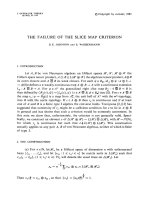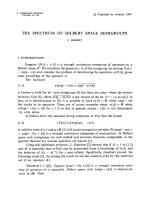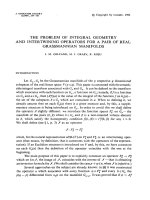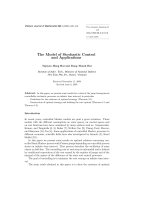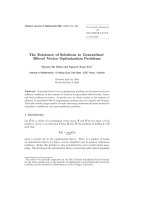Báo cáo toán học: "The Fraction of Subspaces of GF(q)n with a Specified Number of Minimal Weight Vectors is Asymptotically Poisson" pot
Bạn đang xem bản rút gọn của tài liệu. Xem và tải ngay bản đầy đủ của tài liệu tại đây (224.53 KB, 8 trang )
The Fraction of Subspaces of GF(q)
n
with a Specified Number
of Minimal Weight Vectors is Asymptotically Poisson
Edward A. Bender
Center for Communications Research
4320 Westerra Court
San Diego, CA 92121, USA
E. Rodney Canfield
Department of Computer Science
University of Georgia
Athens, GA 30602, USA
Submitted: August 30, 1996; Accepted: November 27, 1996
Abstract
The weight of a vector in the finite vector space GF(q)
n
is the number of nonzero
components it contains. We show that for a certain range of parameters (n, j, k, w)
the number of k-dimensional subspaces having j(q −1) vectors of minimum weight
w has asymptotically a Poisson distribution with parameter λ =
n
w
(q−1)
w−1
q
k−n
.
As the Poisson parameter grows, the distribution becomes normal.
AMS-MOS Subject Classification (1990). Primary: 05A16 Secondary: 05A15, 11T99
the electronic journal of combinatorics 4 (1997), #R3 2
1. Introduction
Almost all the familiar concepts of linear algebra, such as dimension and linear
independence, are valid without regard to the characteristic of the underlying field.
An example of a characteristic-dependent result is that a nonzero vector cannot be
orthogonal to itself; researchers accustomed to real vector spaces must modify their
“intuition” on this point when entering the realm of finite fields.
Let q be a prime power, fixed for the remainder of the paper, and GF(q)be
the finite field with q elements. Because the underlying field is finite, there are
many counting problems associated with fundamental concepts of linear algebra;
for example, how many subspaces of dimension k are there in the vector space
GF(q)
n
? The answer is often denoted
n
k
q
, and we have
n
k
q
=
(1 − q
n
)(1 − q
n−1
) ···(1 − q
n−k+1
)
(1 − q
k
)(1 − q
k−1
) ···(1 − q)
,
the Gaussian polynomial. The reader may consult [2] for an introduction to the
subject.
Define the weight of a vector v in GF(q)
n
to be the number of nonzero coordi-
nates in v. The interaction of weight with familiar concepts of linear algebra yields
more and harder counting problems. Consider the n vectors of weight 1 in GF(2)
n
;
how many vector spaces of dimension k do they span ? The easy answer is the well
known binomial coefficient
n
k
. Now consider the
n
2
vectors of weight 2 in GF(2)
n
;
how many vector spaces of dimension k do they span ? More thought is needed
this time, but again the answer is a classical array from combinatorics, the Stirling
numbers of the second kind S(n, n − k). If we ask the same question for weight 3
or higher, no simple answer is known and the numbers cannot be computed easily.
However, that familiar properties of
n
k
and S(n, k) persist in the higher weight
version is part of a sweeping conjecture that the Whitney numbers of the second
kind for any geometric lattice are log-concave. [1, p.141]
Extend the notion of weight to subspaces by saying that a subspace V ⊆ GF(q)
n
has weight w if w is the minimum weight of all nonzero vectors in V .Anatural
problem is to describe how the
n
k
q
subspaces of dimension k are distributed by
weight. We cannot give a definitive solution to this question, but using asymptotic
methods, we can gain some insight into the problem. The number of weight w
vectors in a vector space over GF(q) is a multiple of q − 1 since multiplication by
a nonzero scalar preserves weight. Let p(j; n, k, w) be the fraction of k-dimensional
subspaces of GF(q)
n
containing j(q −1) vectors of weight w, and no nonzero vector
of weight less than w. Masol [3] showed that
p(0; n, k, 1) − e
−λ
→ 0uniformlyasn→∞where λ = nq
k−n
.
We extend this result as follows:
the electronic journal of combinatorics 4 (1997), #R3 3
Theorem 1. Fix a prime power q, positive constants b ≤
1
2
and B<1−b,anda
function µ(n)=o(1). Then, uniformly for j, k, w satisfying
1 ≤ w ≤ µ(n)n
b
/ log
q
n and λ
def
≡
n
w
(q − 1)
w−1
q
k−n
≤ B log
q
n, (1)
we have
p(j; n, k, w) − λ
j
e
−λ
/j! → 0 as n →∞.
Theorem 2. Fix a prime power q, positive constants b ≤
1
2
and B<1−b,anda
function µ(n)=o((log n)
−1/4
). When (1) holds,
√
2πλ p(j; n, k, w) − e
−(j−λ)
2
/2λ
→ 0 uniformly as λ →∞.
We remind the reader of the meaning of uniformity. A function f : N
→ N goes
to 0 as n →∞, uniformly over A ⊆ N
,provided
sup
a∈A
n
|f (n, a)|→0asn→∞, where A
n
= {a ∈ N
−1
:(n, a) ∈ A}.
Since (q − 1)λ/q
k
is the the probability that a randomly chosen vector has
weight w, the distribution of (q − 1)-tuples of weight w vectors in k-dimensional
subspaces is asymptotically the same as the distribution of weight w vectors in
random samples of
q
k
−1
q−1
(nonzero) vectors: They are asymptotically Poisson with
parameter λ. A point in projective space is the (q − 1)-tuple of scalar multiples of
a nonzero point in GF(q)
n
. Thus, in a projective n-space over GF(q), the previous
observation states that the distribution of weight w points is asymptotically the
same among random sets of
q
k
−1
q−1
points and among random (k − 1)-dimensional
projective subspaces, namely Poisson with parameter λ.
2.Proofofthetheorems
Wewillfinditconvenienttoworkwiththesomewhatlarger
λ
def
≡
(q − 1)
w−1
n
w
q
n−k
w!
≤ B log
q
n, (2)
rather than the definition in (1). Since the ratio of the two versions of λ is
n
w
w!
n
w
=(1−O(w/n))
w
=exp(O(w
2
/n)) = exp(o(1/(log n)
2
)),
it is easily seen that the ratio of the two versions of λ tendsto1andalsothatthe
theoremsforeitherversionofλimply the theorems for the other version. Since the
the electronic journal of combinatorics 4 (1997), #R3 4
ratioofthetwoversionsofλapproach 1, the inequality in (2) follows from that in
(1) by replacing B with the average of B and 1 − b.
Let d = n − k, =(1−b−B)/2, and J =(B+)log
q
n. Making µ(n) larger
if necessary, we may assume
µ(n) ≥ max(n
−b
,e
−
2
log
q
n/4
). (3)
Our proof consists of five parts:
(a) Eliminating small k.
(b) Some easy estimates.
(c) Conversion of the problem to the study of d × n matrices over GF(q).
(d) An estimate for j ≤ J.
(e) Completion of the proof.
Although we will not explicitly state it, all estimates in o(···)andO(···)aswellas
all estimates of the form ···→···are uniform.
(a) Eliminating small k. Suppose Theorem 1 holds for k = k
0
def
≡n/2.We
will deduce that it holds for k<k
0
.Fromtheboundonwin (1), it follows that
λ → 0wheneverk≤k
0
. Since Theorem 1 is equivalent to p(0; n, k, w)=1−o(1)
when λ → 0, it suffices to prove that p(0; n, k, w) ≥ p(0; n, k
0
,w)whenk<k
0
.
To this end we recall a property of downsets in regular ranked posets. A ranked
poset P is regular provided that every element of rank k is comparable to the same
number of elements of rank k + 1, and likewise k − 1. (Thisistherequirement
that each of the bipartite graphs formed by restricting the covering relation of P
to two adjacent ranks be regular in the graph theoretic sense.) For example, both
the subsets of a set and the subspaces of a vector space, ordered by inclusion, are
regular. A downset in a partially ordered set is a set S such that x ∈ S and y<x
imply y ∈ S. We claim that if S is a downset then the fraction |S ∩ P
k
|/|P
k
|
decreases with k,whereP
k
is the set of elements of rank k. To see this, let α and
β be the common degrees of elements in the bipartite graph P
k
× P
k+1
. Clearly
|P
k
|α = β|P
k+1
|. (4)
Since S is a downset, every element of S ∩ P
k+1
is related to β elements of S ∩ P
k
.
Hence
|S ∩ P
k
|α ≥ β|S ∩ P
k+1
|.
Dividing the left side by the left side of (4) and the right side by the right side of
(4) proves the claim.
Let I
j
be the set of subspaces of GF(q)
n
that contain at most j(q −1) vectors
of weight w and no nonzero vectors of less weight. Since this is a downset in the
poset of subspaces of GF(q)
n
, the fraction of k-dimensional subspaces that lie in I
j
is a decreasing function of k and hence p(0; n, k, w) ≥ p(0; n, k
0
,w)whenk<k
0
.
From now on, we assume that k ≥ k
0
= n/2.(5)
the electronic journal of combinatorics 4 (1997), #R3 5
(b)Someeasyestimates. By (1)
λ
2
w
2
/n < J
2
w
2
/n < µ(n)
2
→ 0(6)
and
q
−d
(ej)
w
= λ(q −1)
ejw
(q − 1)n
w
≤ λ(q − 1)
ejw
(q − 1)n
= O(J
2
w/n)(7)
when j ≤ J. Taking logarithms in (2) and using Stirling’s formula, we have
d − Jw = w
log
q
n −log
q
w −J + O(1)
− log
q
λ
= w
(1 −B − )log
q
n−log
q
w + O(1)
− O(log log n).
Fix K.Since1−B− =(1+b−B)/2>b, it follows easily that
w
(1 − B − )log
q
n−log
q
w + K
is an increasing function of w for sufficiently large n. Hence, for sufficiently large n,
d −j(w − 1) ≥ b log
q
n when j ≤ J. (8)
(c) Conversion to d × n Matrices. For V a subspace of GF(q)
n
let V
⊥
be its
orthogonal complement, the set of vectors orthogonal to every element of V .As
noted in the introduction, for nonzero characteristic the intersection V ∩ V
⊥
may
have positive dimension; nevertheless, it is easily checked that the map V → V
⊥
is a bijection from k-dimensional to d-dimensional subspaces. So it suffices to work
with V
⊥
.
Let H be a d × n matrix whose rows form a basis for V
⊥
(in coding theory
terminology, a checksum matrix for V ). Denote the columns of H by h
i
. Note that
v
i
h
i
= 0 if and only if v ∈ V .IfasetSof vectors is linearly dependent and
no proper subset is, then call the set minimally dependent. If w is the minimal
weight in V , the previous discussion shows that there is a bijection between sets
of w minimally dependent vectors among the columns of H and (q − 1)-tuples of
vectors of weight w in V , where a tuple consists of all nonzero multiples of a weight
w vector.
Since every d-dimensional subspace of GF(q)
n
has the same number of ordered
bases, the fraction of ordered bases with a desired property will be the same as
the fraction of d-dimensional subspaces with the property. We will look at ordered
bases.
The rows of H are required to be independent; however, the fraction of all d×n
matrices with this property is
q
−nd
d−1
i=0
(q
n
−q
i
)=
n
t=k+1
(1 − q
−t
)=exp
−
n
t=k+1
q
−t
+ O(q
−2t
)
=exp
O(q
−k
)
=1+O(q
−n/2
),
(9)
the electronic journal of combinatorics 4 (1997), #R3 6
by (5). We can, in effect, ignore the requirement that the rows of H be independent.
(d) An estimate for j ≤ J. In this part of the proof, we will show that
p(j; n, k, w) ≥
λ
j
e
−λ
/j!
1+O(µ(n)
2
)
+O(q
−n/2
)whenj≤J. (10)
It is instructive, and useful, to treat part of the w = 1 case separately. A 1-set
of minimally dependent vectors must be {0}. Hence the fraction of H containing
exactly j such sets is
q
−nd
n
j
(q
d
−1)
n−j
=
n
j
q
jd
j!
exp
O(j
2
/n) − (n − j)q
−d
(1 + O(q
−d
)
uniformly since j = o(n
1/2
). Using, (9), the theorem now follows easily.
For w>1, we generalize this argument. There is a complication: It is now
possible for w-sets of minimally dependent vectors to overlap. We count some of
the subspaces with nonoverlapping cases and show that this consists of almost all
subspaces. Here is how we choose the columns:
(a) Repeat j times: Choose w columns of minimal dependency that are indepen-
dent of the columns already chosen.
(b) Choose the remaining n − jw columns to avoid introducing more dependent
sets of size w or less.
(c) Choose how to order the vectors.
Let N
a
and N
c
be the number of ways to carry out the choices in (a) and (c). The
number of ways to carry out (b) depends on the choices in (a). Let N
b
be a lower
bound on the number of ways to carry out (b). We seek a lower bound for N
a
N
b
N
c
.
Suppose that i sets have been chosen in (a). Since the vectors already chosen
span a space of dimension i(w − 1), the next set can be chosen in
(q
d
− q
i(w−1)
)(q
d
−q
i(w−1)+1
) ···(q
d
−q
i(w−1)+w−2
) × (q − 1)
w−1
ways and so
N
a
=
q
d
(q − 1)
j(w−1)
j(w−1)−1
t=0
(1 − q
t−d
)
=
q
d
(q − 1)
j(w−1)
exp
O(q
j(w−1)−d
)
=
q
d
(q − 1)
j(w−1)
1+O(n
−b
)
by (8).
An upper bound on the number of vectors that can be expressed as a linear
combination of at most w−1 of the vectors in an i-set is h(i, w)=
l≤w−1
(q−1)
l
i
l
.
Thus
N
b
≥
n−1
i=jw
q
d
−h(i, w)
= q
d(n−jw)
n−1
i=jw
exp
−q
−d
h(i, w)+O
q
−2d
h(i, w)
2
the electronic journal of combinatorics 4 (1997), #R3 7
provided the expression inside the O( ) is bounded. Now
q
−d
h(i, w) <q
−d
(q−1)
w−1
n
w − 1
O(1) = O(wλ/n),
and so
N
b
≥ q
d(n−jw)
exp
−q
−d
l≤w−1
(q − 1)
l
n−1
i=jw
i
l
+ O(w
2
λ
2
/n)
(11)
by (6). Note that for w ≥ 1, using Stirling’s formula,
l≤w−1
jw
l +1
= O(1)
jw
w
= O((ej)
w
).
Since
l≤w−1
(q − 1)
l
n−1
i=jw
i
l
=
l≤w−1
(q −1)
l
n
l +1
−
jw
l +1
=(q−1)
w−1
n
w
1+O(w/n)
+ O((ejq)
w
)
=
(q − 1)
w−1
n
w
w!
1+O(w
2
/n)
+ O((ejq)
w
),
we find, using (11), (7), and the definition of λ,
N
b
≥ q
d(n−jw)
exp
−λ
1+O(w
2
/n)
+ O(J
2
w/n)+O(w
2
λ
2
/n)
= q
d(n−jw)
e
−λ
1+O(J
2
w
2
/n)
.
Finally, the number of ways to arrange the vectors, taking into account the fact
that there is already some ordering among them is
N
c
=
n!
j!(w!)
j
(n − wj)!
=
n
wj
j!(w!)
j
1+O(w
2
j
2
/n)
.
Putting all these results together, we obtain the lower bound
N
a
N
b
N
c
≥ q
nd
λ
j
e
−λ
/j!
1+O(J
2
w
2
/n)+O(n
−b
)
. (12)
Equation (10) follows from (9), (12), and (3).
(e) Completion of the Proof. Summing (10) over j ≤ J gives
1 ≥
j≤J
p(j; n, k, w) ≥ (1 + O(µ(n)
2
))e
−λ
j≤J
λ
j
j!
+ O(Jq
−n/2
)
=1+O(µ(n)
2
)−
j>J
λ
j
e
λ
j!
,
(13)
the electronic journal of combinatorics 4 (1997), #R3 8
where the last equality follows from (3), (5), and the definition of J. Since the ratio
of consecutive terms in the last summation is less than
λ
J+1
(J +1)!
λ
J
J!
<λ/J≤
B
B+
=1−
B+
,
we have
j>J
λ
j
e
λ
j!
<
B +
λ
J
e
λ
J!
<
B +
λ
J
J
e
J−λ
.
Since this is an increasing function of λ, it is bounded above by O(D
log
q
n
)where
D =
B
B+
B+
e
.
For a fixed ,
B
B +
B+
increases with B;lettingBequal 1, and using 0 <<1/2
and 1 + ≥ e
−
2
/2
,wesee
D ≤ (1 + )
−1−
e
≤ e
−
2
/2+
3
/2
≤ e
−
2
/4
.
Thus (13) becomes
1 ≥
j≤J
p(j; n, k, w) ≥ 1+O
µ(n)
2
+O(D
log
q
n
)=1+O
µ(n)
2
, (14)
where the last equality follows from (3). It follows that
p(j; n, k, w)=
λ
j
e
−λ
j!
+O(µ(n)
2
)forj≤J (15)
and p(j; n, k, w)=O(µ(n)
2
)forj>J. This completes the proof of Theorem 1.
We now turn to Theorem 2. The standard approximation of the Poisson dis-
tribution by the normal says
√
2πλ
λ
j
e
−λ
j!
− e
−(j−λ)
2
/2λ
→ 0 uniformly in j as λ →∞.
(This can be obtained directly from Stirling’s formula.) Since λ
1/2
µ(n)
2
→ 0,
Theorem 2 follows from (15).
References
1. M. Aigner, Whitney numbers. In N. White (ed.), Combinatorial Geometries,
volume II, Cambridge University Press (1987) 139–160.
2. J. R. Goldman and G C. Rota, On the foundations of combinatorics, IV: Finite
vector spaces and Eulerian generating functions, Studies Appl. Math. 49 (1970)
239–258.
3. V. I. Masol, The asymptotics of the number of k-dimensional subspaces of
minimal weight over a finite field, Random Oper. and Stoch. Eqs. 1 (1993)
287–292.


